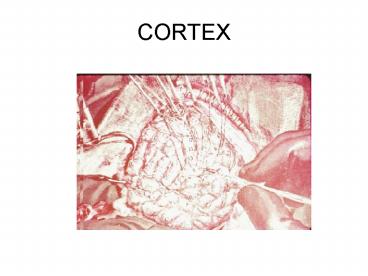CORTEX - PowerPoint PPT Presentation
Title:
CORTEX
Description:
CORTEX * * * * * * * * * * * * HYPOFRONTALITY? Perseveration- a lack of mental flexibility WHY?- the unfortunate story of Egas Moniz and Walter Freeman The Prefrontal ... – PowerPoint PPT presentation
Number of Views:52
Avg rating:3.0/5.0
Title: CORTEX
1
CORTEX
2
CEREBRAL CORTEX
- Wrinkled
- Thin
- Layered
- Interconnected
- Plastic ( consider vs brainstem)
3
Layered
4
Many ways to organize brain
We will adopt the most traditional and simplest
5
Cortical hemispheres
6
Corpus collosum
7
Hemispheres-Corpus collusomectomy
8
The Roger
9
Testing hemispheric functional asymmetries
Tachistoscopic studies Dichotic listening
tasks Sodium amytal tests
10
T-scope approach
11
Functional asymmetries?Roughly 90 of right
handers, and 70 of left handers
12
Popularized Ideas probably go too far-Left
vs Right
- Prefer Classical Music
- Your Left-Brain controls the right side of your
body - Prefer things like instructions to be done
verbally - Good at math
- Like to read
- Follow Western Thought
- Very Logical
- Dog lovers
- Don't enjoy clowning around
- Can't be hypnotized
- Usually remember things only specifically studied
- Need total quiet to read or study
- Like to read realistic stories
- Like to write non-fiction
- Prefer individual counseling
- Enjoy copying or tracing pictures and filling in
details - Also like to read action stories
- Usually rational
- Usually do things in a planned orderly way
- Prefer rock music
- Right brain controls left side of body
- Prefer visual instructions with examples
- Good at sports
- Good at art
- Follow Eastern thought
- Cat lovers
- Enjoy clowning around
- Can be hypnotized
- Like to read fantasy and mystery stories
- Can listen to music or TV while studying
- Like to write fiction
- Prefer group
- Fun to dream about things that will probably
never happen - Enjoy making up own drawings and images
- Good at geometry
- Like organizing things to show relation
- Can memorize music
- Occasionally absentminded
13
More reasonable assertions based on data
Left hemisphere- analytical, rational, verbal,
reading, writing ,math Right Hemisphere-
Intuitive, feeling, spatial processing,
nonverbal, music
14
LOBES
15
LOBES- gyri and sulci
16
OCCIPITAL LOBEprimary visual processing-more
later
17
Temporal Lobes
Primary auditory cortex
Hearing Understanding language (receptive language) Higher visual processing
18
TEMPORAL LOBES-superior temporal gyri
19
Almost like a sound recorder-highly organized
neural responses to sound
20
Temporal lobe and speech-Werniches area-
Werniches apahsia
21
Parietal Lobes
22
Parietal Lobe
Primary somatosensory cortex Visuo-spatial processing
23
Primary Somatosensory CtxThe sensory homunculus
The post central gyrus
24
Your little guy
25
RX for Phantom limb- awareness arises from cortex
independently of reality.
26
Somatosagnosias-perception of reality depends on
CTX
Unilateral neglect anosagnosias
27
FRONTAL LOBES
28
Frontal Lobe functions
Volitional behavior Speech Inhibition of impulses Self-control/temptations Self-initiative Planning/anticipation Self-monitoring Awareness (abilities and limitations) Attention Mental flexibility Problem solving Complex Judgments/goal setting Source monitoring Self-identity Copying Working memory Temporal memory-sequencing Emotion
29
Primary motor cortex-precentral gyrusmore later
30
Speech ccts
31
Speech ccts- Brocas area and Brocas apahsia
32
Suppression of Impulses
- Some scientists contend that the prefrontal
cortex normally acts to suppress or act upon
urges or impulses perhaps by communicating with
other brain areas that mediate fear and
aggression, such as the amygdala.
33
Testing frontal lobe Health-the Wisconsin Card
Sorting Task (WCST)
34
(No Transcript)
35
HYPOFRONTALITY?
- Perseveration- a lack of mental flexibility
36
WHY?- the unfortunate story of Egas Moniz and
Walter Freeman
The Prefrontal lobotomy and the trans-orbital
leucotomy
37
(No Transcript)
38
Can you believe it?





![READ [PDF] Cerebral Cortex: Principles of Operation PowerPoint PPT Presentation](https://s3.amazonaws.com/images.powershow.com/10075968.th0.jpg?_=20240710082)

























